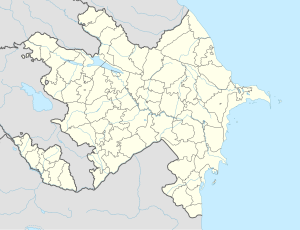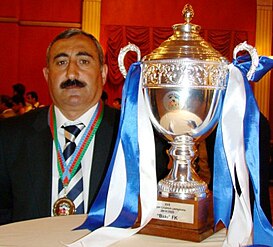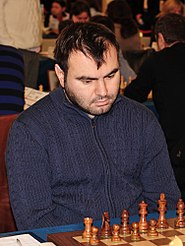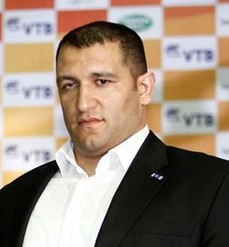Sumgait: Difference between revisions
→External links: add Commons category |
updating |
||
| Line 28: | Line 28: | ||
|website = {{URL|http://www.sumqayit-ih.gov.az/}} |
|website = {{URL|http://www.sumqayit-ih.gov.az/}} |
||
}} |
}} |
||
'''Sumgayit''' ({{IPAc-en|ˌ|s|uː|m|ɡ|ɑː|ˈ|iː|t}};<ref>{{Cite web |url=http://www.dictionary.com/browse/sumgait?s=t |title="Sumgait" ''Dictionary.com'' |access-date=2018-04-15 |archive-url=https://web.archive.org/web/20180416012435/http://www.dictionary.com/browse/sumgait?s=t |archive-date=2018-04-16 |url-status=live |df= }}</ref> {{lang-az|'''Sumqayıt'''}} {{IPA-az|sumgɑˈjɯt|}}, also transliterated as '''Sumgait''' or '''Sumgayit''') is the third-largest city in [[Azerbaijan]], located near the [[Caspian Sea]], about {{convert|31|km|0|abbr=off}} away from the capital, [[Baku]]. The city has a population of around |
'''Sumgayit''' ({{IPAc-en|ˌ|s|uː|m|ɡ|ɑː|ˈ|iː|t}};<ref>{{Cite web |url=http://www.dictionary.com/browse/sumgait?s=t |title="Sumgait" ''Dictionary.com'' |access-date=2018-04-15 |archive-url=https://web.archive.org/web/20180416012435/http://www.dictionary.com/browse/sumgait?s=t |archive-date=2018-04-16 |url-status=live |df= }}</ref> {{lang-az|'''Sumqayıt'''}} {{IPA-az|sumgɑˈjɯt|}}, also transliterated as '''Sumgait''' or '''Sumgayit''') is the third-largest city in [[Azerbaijan]], located near the [[Caspian Sea]], about {{convert|31|km|0|abbr=off}} away from the capital, [[Baku]]. The city has a population of around 343,000, making it the second-largest [[city]] in [[Azerbaijan]] after the capital [[Baku]]. The city has a territory of {{convert|83|km2|0}}. It was founded on November 22, 1949.<ref name=exe>{{cite web |url=http://sumqayit-ih.gov.az/content.php?page=passport |title=Sumqayıt şəhər icra hakimiyyəti. Şəhərin pasportu |trans-title=Sumgayit Executive Power. Resume |access-date=2010-12-29 |url-status=dead |archive-url=https://web.archive.org/web/20101220062500/http://sumqayit-ih.gov.az//content.php?page=passport |archive-date=2010-12-20 |df= }}</ref> Two settlements are within the city administration: [[Corat|Jorat]] and [[Hacı Zeynalabdin|Haji Zeynalabdin]], a settlement named after oil businessman and philanthropist [[Haji Zeynalabdin Taghiyev]]. It is home to [[Sumqayit State University]]. |
||
==Etymology== |
==Etymology== |
||
Revision as of 05:58, 16 November 2019
Sumgayit
Sumqayıt | |
|---|---|
 | |
| Coordinates: 40°35′23″N 49°40′07″E / 40.58972°N 49.66861°E | |
| Country | |
| Founded | November 22, 1949 |
| Government | |
| • Mayor | Zakir Fərəcov |
| Area | |
• Total | 97.17 km2 (37.52 sq mi) |
| Elevation | 26 m (85 ft) |
| Population (2019) | |
• Total | 343,500 |
| • Density | 3,500/km2 (9,200/sq mi) |
| Time zone | UTC+4 (AZT) |
| Area code | +994 18 |
| Website | www |
Sumgayit (/ˌsuːmɡɑːˈiːt/;[1] Template:Lang-az [sumgɑˈjɯt], also transliterated as Sumgait or Sumgayit) is the third-largest city in Azerbaijan, located near the Caspian Sea, about 31 kilometres (19 miles) away from the capital, Baku. The city has a population of around 343,000, making it the second-largest city in Azerbaijan after the capital Baku. The city has a territory of 83 square kilometres (32 sq mi). It was founded on November 22, 1949.[2] Two settlements are within the city administration: Jorat and Haji Zeynalabdin, a settlement named after oil businessman and philanthropist Haji Zeynalabdin Taghiyev. It is home to Sumqayit State University.
Etymology
According to the local folklore the city is named after the Sumqayit River. In retrospect the legend tells the tale of a hero by the name of "Sum", who is chosen by the community to fight a monster that was blocking the Sumgayit River.[3] Sum eventually manages to kill the monster, but when the river is released he is swept by the waters and never seen again. After that, his beloved, Jeyran, inconsolable by Sum's disappearance, would go to the river and cry "Sum qayıt!" (which means "Sum, come back!" in Azerbaijani).[4] So the river became known as Sumgayit, upon the city was named after.
History
Medieval era
According to historians, Medean tribes lived in the area. During the construction boom, when the foundation of the executive power building was being excavated, remains of an ancient caravanserai along with personal items and kitchenware was found at the site.
The first reports of settlements at the present site of Sumgayit were in 1580, when English traveller H. Barrow mentioned Sumgayit in his writings and in 1858, when Alexander Dumas wrote about the area in his memoirs Trip to Caucasus, although nothing substantial was created on the site until the Soviet Union gained control over the area in the 1920s.[5]
Soviet period
Following the politics of glasnost, initiated by Mikhail Gorbachev, civil unrest and ethnic strife grew in various regions of the Soviet Union, including Nagorno-Karabakh,[6] an autonomous region of the Azerbaijan SSR.
On 22–23 February 1988 violence broke out in the town on Askeran, resulting in the death of two Azerbaijanis.[7] The news of the Askeran clash along with ongoing deportation of Azerbaijanis from Armenia sparked the Sumgayit pogrom against Armenian residents of Sumgayit in Azerbaijan on 27 February.[8] The violence was led, to some degree, by Azerbaijani refugees from Armenia, perhaps as many as 2000[9] of them made even more desperate by being forced to take shelter in the appalling conditions of Sumgayit's shantytown.[10] The pogrom resulted in the deaths of over 100 Armenians and six Azerbaijanis. As a result, the entire Armenian population fled from Sumqayit. The violence during the Askeran clash and the Sumgayit Pogrom marked the starting points of Armenian-Azerbaijani conflict, which triggered the Nagorno-Karabakh War.[11]
Republic era
After Nagorno-Karabakh War, the city became home to a number of Azerbaijani refugees internally displaced persons, mainly from Qubadli and Zengilan regions.[12] In 1994, Heydar Aliyev initiated a large-scale Free Economic Area project on the territory of the city.[13]
Geography

Environment
As a result of the Soviet planning of the industrial boom era, the city became heavily polluted. Soon after Azerbaijan's independence, the industrial sectors went into decline. The Absheron Peninsula (which consists of Sumqayit, Baku and the Absheron Rayon) was considered by scientists to be the most ecologically devastated part of Azerbaijan. The city was known for its children's cemetery, known as the "Baby Cemetery" which contains many graves of infants born with deformities and mental retardation that were further complicated by the lack of adequate medical care for the poor.[14] Sumgayit was named as most polluted place on Earth by the U.S.-based environmental group the Blacksmith Institute in 2006 and placed on their list of The World's Most Polluted Places by Time magazine in 2007.[15] The report noted the former Soviet industrial base was polluting the local environment with industrial chemicals like chlorine and heavy metals. The report also mentioned cancer rates in Sumgayit were as much as 51% higher than the national average and that genetic mutations and birth defects were commonplace.[16] The city administration prepared an environmental protection plan for 2003–2010 which has been steadily decreasing the levels of pollution to minimal. The program oversees 118 activities aimed at minimizing pollution at all possible levels of economic production. The program was prepared with participation of all industrial enterprises in the city and its enforcement is being regulated by the executive power of the city. For instance, the amount of waste water from industrial production went down from 600,000 m3 (21,000,000 cu ft) during the 1990s to 76,300 m3 (2,690,000 cu ft) in 2005. Solid waste went down from 300,000 to 3,868 tons a year. The World Bank has issued a loan to the Azerbaijani government for construction of a burial range for mercury waste.[17]
Administrative divisions

The municipality of Sumqayit consists of the city of Sumqayit and the municipalities of Jorat and Haji Zeynalabdin.[18] The mayor, presently Zakir Ferejov, embodies the executive power of the city.[19]
Demographics
According to the State Statistics Committee, as of 2018, the population of city recorded 341.2 thousand persons, which increased by 84500 persons (about 33 persent) from 256.7 thousand persons in 2000.[20] 168,3 thousand of total population are men,172,9 thousand are women.[21] More than 23 percent of the population consists of young people and teenagers aged 14–29.[22]
| Town | 2000 | 2001 | 2002 | 2003 | 2004 | 2005 | 2006 | 2007 | 2008 | 2009 | 2010 | 2011 | 2012 | 2013 | 2014 | 2015 | 2016 | 2017 | 2018 |
|---|---|---|---|---|---|---|---|---|---|---|---|---|---|---|---|---|---|---|---|
| Sumgait town | 285,4 | 287,5 | 289,4 | 291,0 | 292,3 | 294,5 | 296,7 | 299,6 | 302,7 | 308,4 | 311,7 | 314,8 | 318,7 | 325,2 | 329,3 | 332,9 | 336,2 | 339,0 | 341,2 |
- Population: 240,000 inhabitants
- Density of population, per km2: 3621[2]
- Annual population upsurge (pers): 1944
- Average lifetime: 70 years
Ethnic composition
Azerbaijanis 97.74%, Lezgin 1.13%, Russians 0.69%, Talysh 0.15%, Turkish 0.06%, others 0.23%
Until the events of the dissolution of the Soviet Union it was home to 20.000 Armenians, who as a result of pogroms were displaced as refugees.
Religion
Sumqayit did not have a mosque until after the collapse of the Soviet Union.[23] In the 2010s, the city has emerged as a center for Salafism in Azerbaijan, a form of Sunni Islam that advocates a return to Islam's earliest practices.[23][24] The Syrian Civil War and emergence of ISIL forced authorities to take action on crackdown of perceived religious radicals in Sumqayit.[23][25][26]
Economy
| Sumgayit's Economy Soviet Period Timeline[27] |
|---|
|
In 1935, the Soviet government decided to develop heavy industry in the Absheron Peninsula, and the future location of Sumgayit was chosen based on its proximity to Baku and its key position on existing railroad lines.
Between 1938–1941, a thermal power station was constructed to power Baku's growing petroleum industry. This was soon followed by more heavy industries. Due to World War II the construction of the area stopped and resumed in 1944, when metallurgical and chemical plants were constructed and put into operation. The first production of Sumgayit Chemical Plant led to a rapid growth and construction boom, creating a new job market, and a need for a resident population. In 1949, Sumgayit gained official city status according to resolution of the Supreme Soviet of Azerbaijan SSR. In 1952, a tube-rolling plant delivered its first produce thus developing black metallurgy production in Azerbaijan. The same year, another new Synthetic Rubber Production Plant started its operations producing ethylene obtained from oil. Operations at Sumgayit Steel Processing Plant and Sumgayit Aluminium Plant were commenced in 1953 and 1955, respectively. In 1957–1955, a number of scientific research facilities and cultural centers were built, leading to further development of the city infrastructure. In 1960, authorities started building the Petroleum Chemical Factory, the largest in Europe at the time. From 1961 through 1968, a brick-producing factory, a polymer construction materials industrial complex, a phosphor production plant were built. In 1970–'80s, light industry and mechanical engineering facilities were added to the industrial base of the city. By the end of the 1980s, Sumgayit was already the center of the chemical industry of the USSR.[5]
After the dissolution of the Soviet Union, Sumgayit has remained Azerbaijan's second-biggest industrial center after Baku.[13] Some of the most significant companies operating in the city are Azerpipe, Azeraluminium, Sumqayit Aluminium, Sumqayit Superphosphate, glass producer Khazar OJSC, Sumqayit Knitted Goods Factory, and Sumqayit Compressors, many of which have been privatized.[13]
In 2011, the development of Sumgait Technologies Park (STP) and Sumgayit Chemical Industrial Park (SCIP) started to receive investor attention.[13][28] The 167-hectare (410-acre) complex will host pharmaceutical, construction, and agricultural businesses, in addition to chemical, automotive, and electronics producers.[13] It is meant as a self-sufficient complex, which will include residential facilities, an exhibition center, laboratories, sports center, schools, and hospitals. SCIP aims to attract domestic and foreign investors, and its management has already received proposals for 20 investment projects in the complex.[13]
Culture
Symbols
Approximately 50 models which were submitted within three months to the contest, announced for the selection of the Emblem of Sumqayit, were reviewed by a special commission, including experts and community representatives. The new emblem of Sumqayit city was presented on July 22, 2011, at the meeting devoted to the Sumqayit socio-economic development in the first half of the year. The 24 models, which are considered more acceptable during the meeting, were presented to the public. The emblem was officially adopted by the decree of the head of the city executive power.[29]
Architecture
The first studies in architecture and urban planning of the city of Sumgait were carried out by Azerbaijani and Soviet scientist, academician of the International Academy of Architecture of the Eastern Countries, honored architect of Azerbaijan SSR Kamal Mammadbeyov. The result of years of research were numerous scientific publications and a book about architectural and planning development of the city of Sumgait.[30] Mammadbeyov donated a large number of graphics and illustrations made by him to the archives of The City Museum. The Flag Museum in Sumqayit was opened on December 15, 2017 with the participation of Ilham Aliyev.[31][32]
Music and media
Sumgayit was credited as the main regional driving force behind rock bands of the 1990s including Yuxu, Miraj, Mozalan, and Sirr.[33][34]
The regional channel Dünya TV and newspaper 365 Gün are headquartered in the city.[35]
Parks and gardens
During the Soviet rule of Azerbaijan, Sumgayit was believed to have the longest and cleanest boulevard in the republic. The Culture and Leisure Park was laid on 23 hectares (57 acres) of Sumgayit coastline in 1967. On August 17, 1978 the park was given the name of a distinguished Azerbaijani poet Imadaddin Nasimi. The same year, the city administration raised the Peace Dove sculpture and monument in the middle of the park assigning the city a symbol of peace.[36]
The flora of the park includes 39 types of trees. Events of the 1990s such as the Black January tragedy and Nagorno-Karabakh War, led to establishment of Stars (Ulduzlar) and 20 January Monument monuments in the park. In the eastern section of the park, Shehidler Khiyabani, similar to Martyrs' Lane in Baku, was established as burial ground for thousands of soldiers from Sumgayit who died during the war. According to the Decree No. 132 of the Cabinet of Ministers of Azerbaijan dated August 2, 2001 the park was given the status of national historical importance. Its current size is 80 ha.
In addition to Nasimi Culture and Leisure Park, the city administration built Ludwigshafen Park in 1997 in celebration of the 20th anniversary of twin-city relations between Ludwigshafen and Sumgayit. In 1999, Heydar Aliyev Park and Luna Park were built in the rapidly growing city.[37]
Sports
The city has one professional football team competing in the top-flight of Azerbaijani football – Sumgayit, currently playing in the Azerbaijan Premier League.
Transportation
Public transport
The city had a tram system that functioned from 1959 to 2003.[38] Ganja's trolleybus system at its height, it consisted of eight lines and existed until 2006.[39] On June 3, 2015, in Baku, President of Azerbaijan Ilham Aliyev opened the reconstructed Baku-Sumqayit Railway with trains taking 40 minutes from Baku to Sumqayit.[40][41]
Education
As of 2011[update], Sumgayit boasted 49 schools, 13 vocational and music schools, Sumgait Private Turkish High School and a teachers' institute.[13]
The only university in the city is Sumqayit State University. The university has seven departments and approximately 4000 students.
Notable residents
Some of the city's many prestigious residents include: chess players Shakhriyar Mamedyarov, Turkan Mamedyarova and Zeinab Mamedyarova, balaban player Alihan Samedov, footballers Nazim Suleymanov, Kamal Guliyev and Mahir Shukurov, Ilham Zakiyev, two-time world and five-time blind judo champion and two-time gold medalist in the paralympics and karateka Rafael Aghayev.
Archbishop Pargev Martirosyan the current Primate of the Diocese of Artsakh of the Armenian Apostolic Church is also from Sumqayit.
-
Mahir Shukurov, is one of the most capped football players for Azerbaijan national football team.
-
Nazim Suleymanov, Alania Vladikavkaz's all-time goalscorer.
-
Rafael Aghayev, four-time World and eight-time European champion.[42]
-
Shakhriyar Mamedyarov, one of the world's top chess Grandmasters.
-
Ilham Zakiyev, two-time world and five-time blind judo champion and two-time gold medalist in the paralympics.
International relations
Twin towns and sister cities
Sumqayit is twinned with the following cities:[43]
 Rustavi, Georgia, (since 1952)[44]
Rustavi, Georgia, (since 1952)[44] Cherkasy, Ukraine, (since 1972)[44]
Cherkasy, Ukraine, (since 1972)[44] Pitești, Romania, (since 1971)[44]
Pitești, Romania, (since 1971)[44] Ludwigshafen, Germany, (since 1977)[44]
Ludwigshafen, Germany, (since 1977)[44] Bari, Italy, (since 2004)[45]
Bari, Italy, (since 2004)[45] Aktau, Kazakhstan, (since 2009)[46]
Aktau, Kazakhstan, (since 2009)[46] Linz, Austria, (since 2009)[47]
Linz, Austria, (since 2009)[47] Mogilev, Belarus, (since 2009)[48]
Mogilev, Belarus, (since 2009)[48] Nevinnomyssk, Russia, (since 2011)[49]
Nevinnomyssk, Russia, (since 2011)[49] Genoa, Italy, (since 2013)[50]
Genoa, Italy, (since 2013)[50] Zhuzhou, China[43]
Zhuzhou, China[43] Ceyhan, Turkey[43]
Ceyhan, Turkey[43]
See also
References
- ^ ""Sumgait" Dictionary.com". Archived from the original on 2018-04-16. Retrieved 2018-04-15.
- ^ a b "Sumqayıt şəhər icra hakimiyyəti. Şəhərin pasportu" [Sumgayit Executive Power. Resume]. Archived from the original on 2010-12-20. Retrieved 2010-12-29.
- ^ "Əfsanələr". www.sumhistorymuseum.az (in Azerbaijani). Archived from the original on 13 November 2014. Retrieved 18 November 2014.
- ^ "Tarixi Əfsanə". www.sumqayit-ih.gov.az (in Azerbaijani). Archived from the original on 12 November 2014. Retrieved 18 November 2014.
- ^ a b "Sumqayıt şəhər icra hakimiyyəti. Yaranma tarixi" [Sumgayit Executive Power. History]. Archived from the original on 2010-12-20. Retrieved 2010-12-29.
- ^ Michael P., Croissant (1998). The Armenia-Azerbaijan Conflict: causes and implications. United States of America: Praeger Publishers. pp. 36, 37. ISBN 0-275-96241-5.
- ^ The New York Times, 11 March 1988, p. A6
- ^ Ethnic Fears and Ethnic War In Karabagh - Stuart J. Kaufman - Page 23
- ^ Tamara Dragadze, “Azerbaijan and the Azerbaijanis,” in Graham Smith, ed., The Nationalities Question in the Soviet Union (London: Longman, 1990), p. 175.
- ^ Moskovskie novosti, 17 April 1988, tr. in CDSP vol. 40, no. 17, pp. 12–13.
- ^ Modern hatreds: the symbolic politics of ethnic war - Page 63 by Stuart J. Kaufman
- ^ Abbasov, Shahin. "Azerbaijan: Sumgayit Becomes Font of Syria-Bound Jihadists". www.eurasianet.org. Archived from the original on 11 November 2014. Retrieved 11 November 2014.
- ^ a b c d e f g "Renewed Dreams". www.thebusinessyear.com. Archived from the original on 11 November 2014. Retrieved 11 November 2014.
- ^ Sumgayit: Soviet's Pride, Azerbaijan's Hell Archived 2006-05-08 at the Wayback Machine by Arif Islamzade at Azer.com, Autumn 1994
- ^ Sumgayit, Azerbaijan – The World's Most Polluted Places Archived 2007-10-31 at the Wayback Machine TIME, September 12, 2007
- ^ World's Worst Polluted Places Archived 2007-10-27 at the Wayback Machine — by the Blacksmith Institute (accessed 2007-12-3)
- ^ "Sumqayıt şəhər icra hakimiyyəti. Şəhərin ekoloji vəziyyəti" [Sumgayit Executive Power. Environmental conditions in the city]. Archived from the original on 2010-12-20. Retrieved 2010-12-29.
- ^ "Sumqayıt İnzibati-İqtisadi Məhkəməsinin yeni binası". courts.gov.az (in Azerbaijani). Archived from the original on 12 November 2014. Retrieved 12 November 2014.
- ^ "İcra hakimiyyətinin başçısı". www.sumqayit-ih.gov.az (in Azerbaijani). Archived from the original on 12 November 2014. Retrieved 12 November 2014.
- ^ a b "Political division, population size and structure: Population by towns and regions of the Republic of Azerbaijan". The State Statistical Committee of the Republic of Azerbaijan. Archived from the original on 2018-08-27. Retrieved 2018-12-18.
- ^ "Political division, population size and structure: Population by sex, towns and regions, urban settlements of the Republic of Azerbaijan at the beginning of the 2018". The State Statistical Committee of the Republic of Azerbaijan. Archived from the original on 2018-08-27. Retrieved 2018-12-18.
- ^ "Political division, population size and structure: Population at age 14-29 by towns and regions of the Republic of Azerbaijan at the beginning of the 2018". The State Statistical Committee of the Republic of Azerbaijan. Archived from the original on 2018-08-27. Retrieved 2018-12-18.
- ^ a b c Abbasov, Shahin. "Azerbaijan: Sumgayit Becomes Font of Syria-Bound Jihadists". www.eurasianet.org. Archived from the original on 11 November 2014. Retrieved 17 November 2014.
- ^ Howard, Glen E.; Aslanova, Leyla. "Azerbaijani City of Sumgait Emerges as Recruitment Center for Syrian Fighters". www.jamestown.org. Archived from the original on 29 November 2014. Retrieved 17 November 2014.
- ^ "Azerbaijani government's measures to counter terrorism and civil unrest risks expected to ensure stability in three-year outlook". www.ihs.com. Archived from the original on 29 November 2014. Retrieved 17 November 2014.
- ^ Lomsadze, Giorgi. "Azerbaijan Arrests Alleged ISIS and Other Islamic Fighters". www.eurasianet.org. Archived from the original on 18 November 2014. Retrieved 17 November 2014.
- ^ Template:Ru icon Karabakh: Timeline of the Conflict Archived 2011-08-10 at the Wayback Machine. BBC Russian
- ^ Barron, Lisa. "Azerbaijan's Sumgayit industrial park may spur new job growth". cistranfinance.com. Archived from the original on 11 November 2014. Retrieved 11 November 2014.
- ^ "Sumqayıtın gerbi qəbul edilmişdir" [The Sumqayit Emblem has been accepted.]. azertag.az (in Azerbaijani). Archived from the original on 2018-12-18. Retrieved 2018-12-18.
- ^ Mamedbekov, Kamal (1988). Sumgait: Architectural and planning development. Baku: Elm, Academy of Sciences of Azerbaijan SSR. p. 119. Archived from the original on 2014-09-27. Retrieved 2013-01-03.
- ^ "Official web-site of President of Azerbaijan Republic - Events Ilham Aliyev inaugurated Flag Museum in Sumgayit". en.president.az. Retrieved 2018-12-18.
- ^ "President Ilham Aliyev inaugurated Flag Museum in Sumgayit VIDEO". azertag.az. Archived from the original on 2018-12-19. Retrieved 2018-12-18.
- ^ "Yenə də Sumqayıt…". sumqayitxeber.com (in Azerbaijani). Archived from the original on 9 November 2014. Retrieved 30 June 2014.
- ^ "Sumqayıt rok ənənələrini bərpa edir". www.inradiotv. (in Azerbaijani). Archived from the original on 9 November 2014. Retrieved 30 June 2014.
- ^ "Radio-TV yayımı" (in Azerbaijani). Archived from the original on 27 October 2014. Retrieved 13 November 2014.
- ^ K. Zarbaliyeva (2010-10-06). "Sumqayıt nümayəndə heyəti Mogilyovda səfərdədir" [Sumgayit delegation is visiting Mogilev]. Trend News Agency. Archived from the original on 2010-12-25. Retrieved 2010-12-29.
- ^ "Sumqayıt şəhər icra hakimiyyəti. Parklar və istirahət bağları" [Sumgayit Executive Power. Parks and Leisure facilities]. Archived from the original on 2010-12-20. Retrieved 2010-12-29.
- ^ "16. Сумгаит (трамвай)" [16. Sumqayit (tram)]. Горэлектротранс (Electrotrans) website (in Russian). Дмитрий Зиновьев (Dmitry Zinoviev). Archived from the original on 31 January 2013. Retrieved 23 September 2012.
- ^ "17. Сумгаит (троллейбус)" [17. Sumqayit (trolleybus)]. Горэлектротранс (Electrotrans) website (in Russian). Дмитрий Зиновьев (Dmitry Zinoviev). Archived from the original on 4 January 2013. Retrieved 23 September 2012.
- ^ az:Bakı-Sumqayıt qatarı
- ^ "Archived copy". Archived from the original on 2018-03-13. Retrieved 2018-03-13.
{{cite web}}: CS1 maint: archived copy as title (link) - ^ Рафаэль Агаев – семикратный чемпион Европы! Archived 2010-05-09 at the Wayback Machine Template:Ru icon
- ^ a b c "Twin-cities of Azerbaijan". Azerbaijans.com. Archived from the original on 2013-08-09. Retrieved 2013-08-09.
- ^ a b c d "Sumqayit's history". www.sumhistorymuseum.az (in Azerbaijani). Archived from the original on 13 November 2014. Retrieved 13 November 2014.
- ^ "EXECUTIVE ORDER OF PRESIDENT OF THE AZERBAIJAN REPUBLIC". azertag.az. Archived from the original on 13 November 2014. Retrieved 13 November 2014.
- ^ ""Sumqayıt şəhəri (Azərbaycan Respublikası) və Aktau şəhəri (Qazaxıstan Respublikası) arasında qardaşlaşmış şəhər münasibətlərinin yaradılması haqqında Birgə Bəyannamə"ni imzalamaq səlahiyyətinin verilməsi barədə". e-qanun.az (in Azerbaijani). Archived from the original on 13 November 2014. Retrieved 13 November 2014.
- ^ "SUMGAIT TO BE TWINNED WITH AUSTRIA`S LINZ". www.oananews.org. Archived from the original on 13 November 2014. Retrieved 13 November 2014.
- ^ "Archived copy" Могилев и азербайджанский Сумгаит подписали договор о побратимстве. gorki.gov.by (in Russian). Archived from the original on 13 November 2014. Retrieved 13 November 2014.
{{cite web}}: CS1 maint: archived copy as title (link) - ^ "Archived copy" У Сумгайыта появился город-побратим. news.day.az (in Russian). Archived from the original on 9 December 2014. Retrieved 13 November 2014.
{{cite web}}: CS1 maint: archived copy as title (link) - ^ "Siglato il memorandum d'intenti tra Genova e Sumqayit, città azera". www.comune.genova.it (in Italian). Archived from the original on 13 November 2014. Retrieved 13 November 2014.











